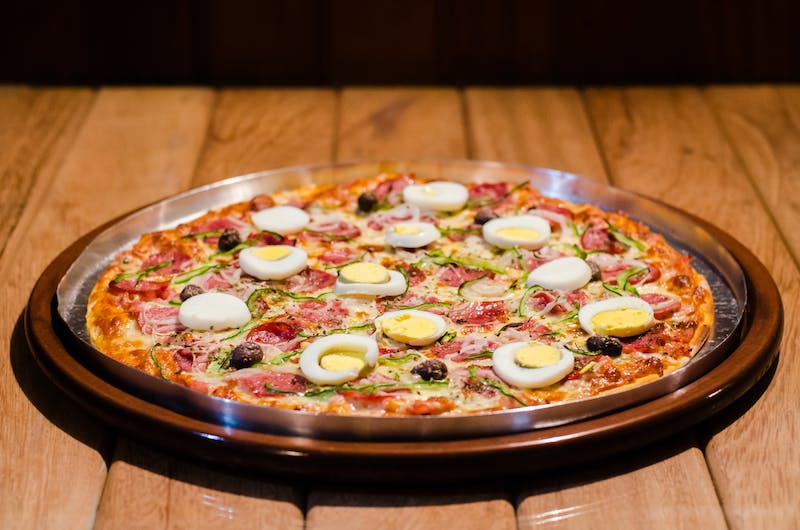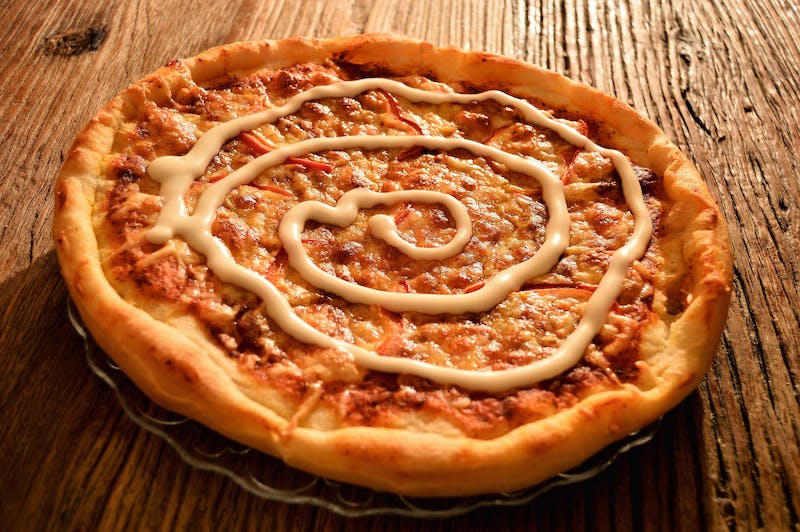When it comes to feeding a crowd or satisfying a serious pizza craving, size definitely matters—and the 18-inch pizza stands out as a formidable option. But just how big is an 18 inch pizza, and what does that mean for your next gathering or family dinner night? Understanding the dimensions and implications of ordering an 18-inch pizza is essential for anyone looking to maximize their dining experience, ensure no guest goes hungry, and get the best value for their money.
In this comprehensive article, we’ll dive deep into the world of the 18-inch pizza, a size that often goes beyond the standard offerings at many pizzerias. We’ll explore not only its physical size and surface area but also how it compares to other pizza sizes in terms of slices, servings, and the all-important factor of topping distribution. With a keen eye on the mathematics of pizza geometry, we’ll reveal why the 18-inch option might just be the smartest choice for your next big event or cozy night in.
Brief Overview of Pizza Popularity
Pizza’s origins stretch back over 2000 years to ancient Greek and Roman flatbreads. But its modern incarnation began in Italy in the 19th century when bakers in Naples began topping rounds of yeast-leavened dough with tomato sauce and cheese. From there, pizza proliferated globally, becoming one of the world’s most ubiquitous and beloved foods.
Some key facts and figures on pizza’s popularity today:
- 13% of Americans eat pizza on any given day, eating 3 billion pizzas per year nationally.
- Globally, over 5 billion pizzas are sold every year.
- Pepperoni is the most popular pizza topping in the United States.
- Saturday is the most popular day to eat pizza.
- Pizza has become an over $45 billion a year industry in the United States.
How Big is an 18 Inch Pizza?
Discover the perfect size for feeding a group: the 18-inch pizza. With a diameter of approximately 45.72 cm, this large pizza comfortably serves 8-10 people with 8 slices, or up to 12 slices if you prefer a thin crust. Surprisingly, an 18-inch pizza offers more value than two 12-inch pizzas, covering about 254 square inches compared to their combined 226 square inches.
Ideal for gatherings and parties, this size is cost-effective and accommodating to different preferences. Fall between the sizes of a 16-inch and a 20-inch pizza, the 18-inch option provides a generous amount of toppings for sharing and enjoying a variety of flavors. Upgrade your pizza game with the perfect balance between size and taste – choose an delightful 18-inch pie for your next gathering or event.
Comparison to Other Pizza Sizes
12-inch vs. 16-inch vs. 18-inch Pizzas
Here is how three typical pizza sizes stack up:
| Pizza Size | Diameter | Area* | % Larger than 12″ pizza |
|---|---|---|---|
| 12-inch | 12 inches | 113 sq inches | – |
| 16-inch | 16 inches | 201 sq inches | 78% larger |
| 18-inch | 18 inches | 254 sq inches | 125% larger |
(*Area calculated using pizza radius squared x pi formula)
A couple key takeaways:
- At 18 inches wide, the 18-inch pizza has a total surface area over 2x as large as a 12-inch pizza.
- It is also approximately 20% larger in area than a 16-inch pizza.
So when bumping up to an 18-inch from the popular 12-inch, you gain a lot of additional pizza real estate. Next let’s look at how the dimensions affect number of slices and portions.
Slice by Slice: Portions and Number of Slices
With a larger surface area to work with, an 18-inch pizza can be cut into more generous slices:
- A 12-inch pizza is often cut into 6-8 slices.
- A 16-inch pizza is often cut into 8-10 slices.
- For an 18-inch pizza, a typical division would be 10-12 slices.
So each individual slice from an 18-inch pie will be bigger and more filling than a slice from a smaller pizza. Perfect for hungry crowds and big appetites.
The number of slices can also be adjusted based on the event and group size:
- Cut into 8 massive slices for a smaller get-together.
- Or slice into 16 slimmer slices to serve a larger party.
This flexibility makes the 18-inch size ideal for gatherings of varying hungry masses.
Feeding a Crowd
One key advantage of the 18-inch pizza is the ability to feed a larger group. Some example scenarios where these extra-large pies are perfect:
- Birthday parties
- Game nights
- Club or team gatherings
- Family events
- Holiday celebrations
- Company parties
A good rule of thumb is that each slice from an 18-inch pizza will satisfy 1 hungry adult. So to serve 10-15 adults, ordering 2-3 pies is ideal.
For bigger groups of say 25-30 people, bump up the pie count to 4-5 total 18-inch pizzas. Perfect for keeping the whole party satisfied and happy.
Value for Money
Beyond just having more overall pizza to go around, the 18-inch size can provide advantages in terms of value and cost efficiency. Let’s analyze the price considerations in more detail.
Price Advantage
Read on to learn more : All About Ooni Koda vs Karu: Find Your Perfect Pizza Oven
Comparing pizza prices at major national chains in the United States:
- 12-inch pizza: Approximately $10
- 16-inch pizza: Approximately $15
- 18-inch pizza: Approximately $18
So stepping up just 2 inches from a 16-inch to an 18-inch pizza only incurs a few extra dollars in cost. But you gain over 20% more pizza area, which means more food overall for minimal extra money. A great value.
Cost Per Square Inch
Looking at per area costs:
- 12-inch pizza: Around $0.08 per sq inch
- 16-inch pizza: Around $0.07 per sq inch
- 18-inch pizza: Around $0.07 per sq inch
The per square inch cost drops when sizing up to 16-inch or 18-inch pizzas. So you save a bit per piece of pizza ordered.
Cost Per Slice
Finally, comparing per slice with 12 slices per pizza:
- 12-inch pizza: $0.80 per slice
- 16-inch pizza: $1.25 per slice
- 18-inch pizza: $1.50 per slice
Still very comparable per slice costs between sizes. So the 18-inch gives you a larger slice with only slightly higher price.
Overall, the 18-inch pizza provides great economic value, maximizing food quantity with reasonable costs.
The Topping Territory

Beyond just the crust and surface area, the size of a pizza also impacts topping distribution and flavor experience. Here is how an 18-inch pizza fares in the topping department.
Topping Distribution
With a larger surface area, there are more opportunities to add toppings and distribute them evenly across an 18-inch pizza. Benefits include:
- More of each topping per slice.
- Wider range of flavors in one slice.
- Preventing topping clumps and unevenness.
This even distribution allows every bite to deliver prime pizza goodness.
Flavor Experience
More space also means more room for premium flavor options:
- Extra cheese for an ultra-cheesy pie.
- A medley of meats like pepperoni, sausage, bacon, and ham.
- Loads of vegetables to make it a Supreme.
- Unique creations like mac & cheese pizza or breakfast pizza.
With an 18-inch pizza, the flavor possibilities are endless for a truly out-of-this-world culinary experience.
Nutritional Deep Dive
Along with expanded flavors, the larger size significantly impacts the dietary and caloric intake when consuming these hungry person’s pies. Let’s analyze how the 18-inch pizza stacks up nutrition-wise.
Calorie Comparison
Looking at pizzas with a classic pepperoni topping:
| Pizza Size | Sample Slices | Total Calories | Calories Per Slice |
|---|---|---|---|
| 12-inch | 6 slices | 1560 calories | 260 calories |
| 16-inch | 8 slices | 2400 calories | 300 calories |
| 18-inch | 10 slices | 3300 calories | 330 calories |
As expected, the calorie counts scale up with the larger sizes and slices. Important to account for if monitoring your food intake.
Impact of Toppings and Crust
Adding extra meats, cheeses, vegetables, and thicker crusts will further increase calorie counts:
- An 18-inch deep dish pizza can exceed 4000+ calories total.
- With a 5-cheese 18-inch pizza, slices could approach 500+ calories each.
So ingredient choices greatly impact overall nutrition too.
Healthier Options
Thankfully there are ways to lighten up an 18-inch pizza:
- Cauliflower crust or gluten-free crust reduces calories.
- Loading up on veggie toppings like mushrooms, onions, spinach.
- Opting for lighter cheese like parmesan instead of fatty mozzarella.
- Requesting a well-done pie to let grease drain off.
Being mindful with ingredients and cooking can help balance out the larger size.
The Dough Down: Crust Comparisons
Read on to learn more : How Many Calories In A Slice Of Pepperoni Pizza? Enjoying
A pizza’s crust is the foundation holding up those delicious toppings. How does crust change with an 18-inch pizza?
Crust Thickness
Traditionally, 18-inch pizzas have a thinner, crisper crust than a 12-inch or 16-inch pie. Benefits include:
- Allowing the slice to be picked up and folded easier.
- Reducing overall calories and carbs.
- Preventing a doughy texture.
This crust suits the larger size and quantities eaten well.
Crust Types
While a hand-tossed thin crust is common, 18-inch pizzas can also utilize thicker or alternative crusts:
- A deep dish style with taller crust edges to hold in toppings.
- A stuffed crust packed with cheese, sauce, or spices.
- A gluten-free or cauliflower crust, as mentioned earlier.
The expansive canvas of an 18-inch pizza invites creativity with crust choices.
Economic and Cultural Considerations
Beyond just nutrition, there are some other interesting economic and cultural factors surrounding 18-inch pizzas to consider.
Cost-Benefit Analysis
Let’s summarize the key value components of the 18-inch pizza:
Pros:
- Feeds more people per pie.
- Slightly lower per square inch cost.
- Provides larger individual slices.
Cons:
- Overall more expensive than small sizes.
- Requires more storage space.
- Can increase waste if leftovers aren’t consumed.
Verdict: The 18-inch pizza makes sense for feeding large groups, but smaller pies may be more practical for individual meals.
Cultural Pizza Preferences
Pizza sizes and preferences also vary globally:
- In Italy, smaller personal-sized pies are favored.
- American culture embraces large shared pizzas.
- Japan inspired micro-gourmet pizzas with unique flavors.
Cultural traditions shape how pizza is appreciated in different ways around the world.
Consumer Behavior and Preferences

Now that 18-inch pizzas are widely available, they account for a growing share of pizza orders, especially for certain occasions.
Group Occasions
According to pizza restaurants, 18-inch pies account for 20-30% of orders for group events and gatherings. Their ability to feed more makes them highly popular in these settings.
Weekend Meals
18-inch pizzas also see more orders on Fridays and Saturdays, when families are often looking to share a meal together or have friends over. The bigger pies are more suitable to these weekend social gatherings.
Younger Generations
Polling indicates Millennials and Gen Zers tend to have the strongest preferences for the 18-inch compared to Baby Boomers. Their bigger appetite for both pizza and shared food experiences drives this trend.
So keep an eye out for the 18-inch pizza preference to continue rising over time, especially with younger demographics.
Conclusion: How Big Is An 18 Inch Pizza?
So what’s the final ruling on the 18-inch pizza – is it a wonder or waistline wrecker? The answer likely comes down to the scenario and personal preferences. For feeding ravenous crowds at game night or birthdays, the 18-inch pizza rules as the perfect party pie. When craving an occasional indulgence with family or friends, it satisfies the collective craving. And innovating with healthier ingredients and portion control provides balance.
However, for individual meals the smaller sizes likely still reign supreme in terms of practicality and nutrition. But never say never – even solo, going big can be a fun way to switch up pizza night every once in a while. The 18-inch pizza has cemented its place in the pantheon of pies and will continue to satisfy big appetites and occasions for the foreseeable future. So next time you’re looking to serve a hungry crowd, dream up the ultimate over-the-top 18-inch pie creation.

Chef John Sebastian has been cooking up a storm at his simple place for years. Offering a variety of international foods, Chef John Sebastian has something for everyone- and he makes it all look easy!
He’s been featured in various food magazines and cooking shows, and his restaurant has become a local favorite in the community. When he’s not in the kitchen, Chef John Sebastian enjoys spending time with his family.









